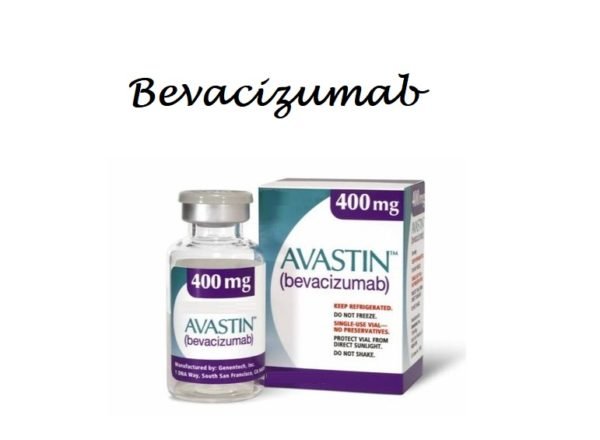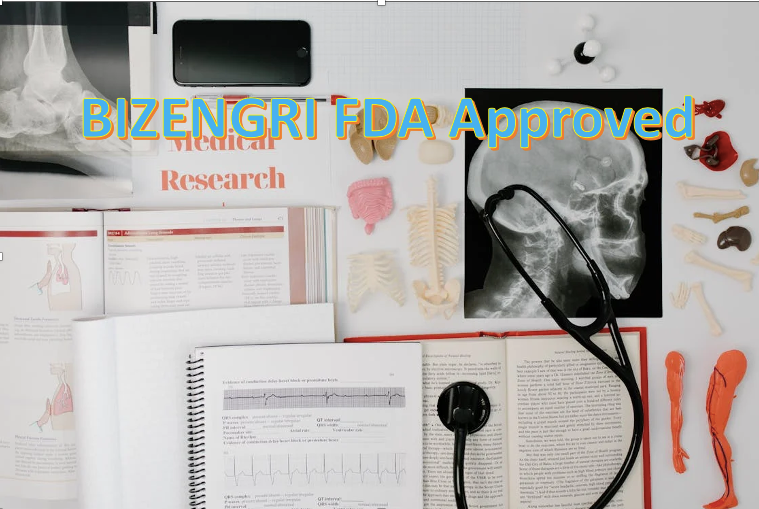Bevacizumab (Avastin) is a humanized monoclonal antibody that binds and neutralizes the vascular endothelial growth factor and prevents its association with endothelial receptors, Flt-1 and KDR.
Inhibition of the vascular endothelial growth factor results in the inhibition of angiogenesis and new vessel formation.
It is thus used in a variety of conditions, primarily mitotic processes.
Parents who have undergone surgical intervention, administration of the drug should be delayed for at least 28 days until the wound has completely healed.
Avastin-associated blindness:
Recently, there have been cases of blindness reported with Avastin injection when administered intravitreal.
Avastin is used to treat macular edema, however, severe endophthalmitis resulting in blindness have occurred in patients.
It is not known why patients developed endophthalmitis.
Infection, immune reactions, thrombosis, issues related to cold chain maintenance could all be responsible.
Bevacizumab (Avastin) Uses:
- It is used in combination with paclitaxel and either cisplatin or topotecan to treat patients with recurrent, metastatic, or persistent cervical cancer.
- In combination with fluorouracil-based chemotherapy, it is used as a first or second-line treatment for metastatic colorectal cancer.
- In combination with fluoropyrimidine-irinotecan- or fluoropyrimidine-oxaliplatin-based chemotherapy, it is used as a second line of treatment for metastatic colorectal cancer if the disease progresses with the first line of treatment. It is, however, not indicated for the adjuvant treatment of colon cancer.
- It is used to treat recurrent and progressive Glioblastoma as a single agent in patients with progressive disease.
- It is indicated as a first-line treatment in combination with carboplatin and paclitaxel of locally advanced, unresectable, recurrent, and metastatic non-small cell lung cancer.
- It is used in combination with interfering alpha for the treatment of metastatic renal cell carcinoma.
- It is indicated for the treatment of ovarian, fallopian tube, and primary peritoneal cancer:
- Following initial surgical resection in the treatment of stage III epithelial ovarian, fallopian tube, or primary peritoneal cancer in combination with carboplatin and paclitaxel, followed by single-agent bevacizumab.
- For the treatment of platinum-resistant recurrent epithelial ovarian, fallopian tube, or primary peritoneal cancer in combination with paclitaxel, liposomal doxorubicin, or topotecan.
- in combination with carboplatin and paclitaxel or with carboplatin and gemcitabine and then followed by single-agent bevacizumab for the treatment of platinum-sensitive recurrent epithelial, ovarian, fallopian tube, or primary peritoneal cancer.
-
Off label Uses of Bevacizumab in Adults include:
- Age-related macular degeneration
- Metastatic Breast cancer
- Diabetic macular edema
- Recurrent or persistent endometrial cancer
- Hereditary hemorrhagic telangiectasia
- Unresectable malignant pleural mesothelioma
- Angiosarcoma and hemangiopericytoma (Soft tissue sarcomas)
Bevacizumab Dose in Adults:
Bevacizumab dose in the treatment of Cervical cancer:
- 15 mg/kg intravenously every 3 weeks until the disease progresses or the drug can not be tolerated (in combination with paclitaxel and either cisplatin or topotecan)
Avastin dose in the treatment of colorectal cancer:
- 5 mg/kg Intravenously every 14 days (in combination with bolus-IFL) or
- 10 mg/kg every 14 days (in combination with FOLFOX4)
Avastin dose in the treatment of metastatic colorectal cancer following first-line therapy containing bevacizumab:
- 5 mg/kg Intravenous every 14 days or
- 5 mg/kg every 21 days (in combination with fluoropyrimidine-irinotecan or fluoropyrimidine-oxaliplatin based regimen)
Avastin dose in the treatment of Glioblastoma:
- 10 mg/kg Intravenous every 14 days as a single agent until disease progression or unacceptable toxicity or
- 10 mg/kg every 14 days (in combination with irinotecan) until disease progression or unacceptable toxicity.
Bevacizumab dose in the treatment of Non-small cell lung cancer as first-line therapy:
- 15 mg/kg Intravenous every 21 days (in combination with carboplatin and paclitaxel) for 6 cycles.
-
Off-label combinations:
- 15 mg/kg every 21 days (in combination with pemetrexed and carboplatin) for up to 4 cycles or
- 5 mg/kg every 21 days (in combination with pemetrexed and cisplatin) for 4 cycles or
- 15 mg/kg every 21 days (in combination with atezolizumab, paclitaxel, and carboplatin) for 4 to 6 cycles
-
Maintenance therapy:
- After 6 cycles of induction therapy with bevacizumab, carboplatin, and paclitaxel it is given in a dose of 15 mg/kg every 21 days as a single agent. It is continued until disease progression or unacceptable toxicity or
- Following 4 cycles of induction therapy with bevacizumab, pemetrexed, and carboplatin, it is given in a dose of 15 mg/kg in combination with pemetrexed every 21 days until disease progression or unacceptable toxicity or
- Following 4 cycles of induction therapy with bevacizumab, cisplatin, and pemetrexed, it is given in a dose of 5 mg/kg in combination with pemetrexed every 21 days until disease progression or unacceptable toxicity or
- Following 4 to 6 cycles of induction therapy with atezolizumab, paclitaxel, and carboplatin, it is given in a dose of 15 mg/kg every 21 days, with or without maintenance atezolizumab until disease progression or unacceptable toxicity.
Bevacizumab dose in the treatment of Ovarian (epithelial), fallopian tube, or primary perioteneal cancer:
- 15 mg/kg intravenous every 21 days in combination with carboplatin and paclitaxel for up to 6 cycles, followed by bevacizumab 15 mg/kg every 21 days as monotherapy, for a total of up to 22 cycles or until disease progression.
- The administration of bevacizumab may be delayed until cycle 2 to reduce the risk of wound healing complications.
Bevacizumab dose in the treatment of platinum-resistant recurrent Ovarian (epithelial), fallopian tube, or primary peritoneal cancer:
- 10 mg/kg intravenous every 14 days in combination with weekly paclitaxel, every 4 weeks liposomal doxorubicin, or days 1, 8, and 15 topotecan) or
- 15 mg/kg every 21 days in combination with every 21 days topotecan.
Bevacizumab use in the treatment of platinum-sensitive recurrent Ovarian (epithelial), fallopian tube, or primary peritoneal cancer:
- 15 mg/kg Intravenous every 21 days in combination with carboplatin and gemcitabine for 6 to 10 cycles or with carboplatin and paclitaxel for 6 to 8 cycles, then continue with bevacizumab until the disease progresses or toxicity develops.
Bevacizumab dose in the treatment of metastatic Renal cell cancer:
- 10 mg/kg Intravenous every 14 days in combination with interferon alfa or
- 10 mg/kg every 14 days as monotherapy.
Bevacizumab dosage for Age-related macular degeneration:
- 25 mg (0.05 ml) intravitreal monthly for 3 months, then monthly or as needed based on an ophthalmologic assessment performed at least once a month.
Bevacizumab dosage for metastatic Breast cancer:
- 10 mg/kg Intravenous every 14 days in combination with paclitaxel.
Bevacizumab dosage for Diabetic macular edema:
- 25 mg (0.05 ml) Intravitreal initially.
- It is repeated every month depending on the response as measured by visual acuity or central subfield thickness assessment.
Avastin dose in the treatment of recurrent or persistent endometrial cancer:
- 15 mg/kg Intravenous every 21 days as monotherapy until the disease progresses or toxicity develops.
Avastin dose in the treatment of hereditary hemorrhagic telangiectasia:
- 5 mg/kg Intravenous every 14 days for 6 doses or
- 5 mg/kg every 14 days for 4 doses, followed by 5 mg/kg once a month for 4 doses.
- If required, additional doses may be administered.
Avastin dose in the treatment of unresectable malignant pleural mesothelioma:
- 15 mg/kg Intravenous every 21 days in combination with pemetrexed and cisplatin for up to 6 cycles.
- This is followed by bevacizumab maintenance therapy at 15 mg/kg once every 21 days until toxicity develops or if the disease progresses.
Avastin dose in the treatment of metastatic or locally advanced Soft tissue sarcoma and angiosarcoma:
- 15 mg/kg Intravenous every 21 days until the disease shows signs of progression or toxicity develops.
Bevacizumab dose in Children:
Avastin dosage in the treatment of Refractory solid tumor:
- Children and Adolescents:
- 5 to 15 mg/kg/dose intravenous every 14 days in a 28-day course or
- 5 to 10 mg/kg every 2 to 3 weeks.
Bevacizumab dosage in the treatment of recurrent or refractory medulloblastoma and Gliomas:
- Children and Adolescents:
- 10 mg/kg/dose Intravenous every 14 days in combination with irinotecan with or without temozolomide or
- 15 mg/kg/dose every 21 days has also been used.
Bevacizumab dose in Renal impairment:
- Recommendations in the dose adjustment has not been provided by the manufacturer if renal impairment is present prior to the treatment.
- However, the treatment must be discontinued if the patient develops nephrotic syndrome.
- Patients who develop proteinuria that equals to or exceeds 2 gms should withhold the treatment until the proteinuria is less than 2 gms/ 24 hours.
Bevacizumab dosage in Hepatic impairment:
- The adjustment in dose has not been provided by the manufacturer in patients with liver disease.
Bevacizumab Side effects:
Common Side Effects of Bevacizumab include:
-
Cardiovascular:
- Hypertension
- Venous Thromboembolism
- Peripheral Edema
- Hypotension
- Venous Thromboembolism
- Arterial Thrombosis
-
Central Nervous System:
- Fatigue
- Pain
- Headache
- Dizziness
- Insomnia
- Taste Disorder
- Peripheral Sensory Neuropathy
- Anxiety
- Myasthenia
-
Dermatologic:
- Alopecia
- Exfoliative Dermatitis
- Palmar-Plantar Erythrodysesthesia
- Xeroderma
-
Endocrine & Metabolic:
- Ovarian Failure
- Hyperglycemia
- Hypomagnesemia
- Weight Loss
- Hyponatremia
- Hypoalbuminemia
- Hypocalcemia
-
Gastrointestinal:
- Nausea
- Abdominal Pain
- Vomiting
- Anorexia
- Constipation
- Diarrhea
- Decreased Appetite
- Stomatitis
- Gastrointestinal Hemorrhage
- Dyspepsia
- Mucosal Inflammation
-
Genitourinary:
- Proteinuria
- Urinary Tract Infection
- Pelvic Pain
-
Hematologic & Oncologic:
- Thrombocytopenia
- Hemorrhage
- Leukopenia
- Pulmonary Hemorrhage
- Neutropenia
- Bruise
- Lymphocytopenia
-
Infection:
- Infection
-
Neuromuscular & Skeletal:
- Arthralgia
- Myalgia
- Limb Pain
- Back Pain
- Dysarthria
-
Renal:
- Increased Serum Creatinine
-
Respiratory:
- Epistaxis
- Upper Respiratory Tract Infection
- Cough
- Dyspnea
- Allergic Rhinitis
- Oropharyngeal Pain
- Sinusitis
- Nasal Sign & Symptoms
- Rhinitis
-
Miscellaneous:
- Postoperative Wound Complication
Less Common Side Effects Of Bevacizumab Include:
-
Cardiovascular:
- Thrombosis
- Deep Vein Thrombosis
- Chest Pain
- Intra-Abdominal Thrombosis
- Syncope
- Left Ventricular Dysfunction
- Pulmonary Embolism
-
Central Nervous System:
- Voice Disorder
-
Dermatologic:
- Nail Disease
- Dermal Ulcer
- Cellulitis
- Acne Vulgaris
-
Endocrine & Metabolic:
- Dehydration
- Hyperkalemia
- Hypokalemia
-
Gastrointestinal:
- Hemorrhoids
- Xerostomia
- Gingival Hemorrhage
- Rectal Pain
- Colitis
- Intestinal Obstruction
- Gastrointestinal Perforation
- Gastroesophageal Reflux Disease
- Gingivitis
- Oral Mucosa Ulcer
- Gastrointestinal Fistula
- Gastritis
- Gingival Pain
-
Genitourinary:
- Vaginal Hemorrhage
-
Hematologic & Oncologic:
- Febrile Neutropenia
- Neutropenic Infection
- Hemorrhage
-
Hepatic:
- Increased Serum AST
-
Infection:
- Abscess
-
Neuromuscular & Skeletal:
- Weakness
- Neck Pain
-
Ophthalmic:
- Blurred Vision
-
Otic:
- Tinnitus
- Deafness
-
Respiratory:
- Rhinorrhea
- Nasal Congestion
- Pneumonitis
-
Miscellaneous:
- Fistula
- Infusion Related Reaction
Bevacizumab (including biosimilars of bevacizumab): Drug Interaction
|
Risk Factor C (Monitor therapy) |
|
|
Bisphosphonate Derivatives |
Angiogenesis Inhibitors (Systemic) may enhance the adverse/toxic effect of Bisphosphonate Derivatives. Specifically, the risk for osteonecrosis of the jaw may be increased. |
|
Chloramphenicol (Ophthalmic) |
May enhance the adverse/toxic effect of Myelosuppressive Agents. |
|
CloZAPine |
Myelosuppressive Agents may enhance the adverse/toxic effect of CloZAPine. Specifically, the risk for neutropenia may be increased. |
|
Promazine |
May enhance the myelosuppressive effect of Myelosuppressive Agents. |
|
SORAfenib |
Bevacizumab may enhance the adverse/toxic effect of SORAfenib. Specifically, the risk for hand-foot skin reaction may be increased. |
|
Risk Factor X (Avoid combination) |
|
|
Anthracyclines |
Bevacizumab may enhance the cardiotoxic effect of Anthracyclines. |
|
BCG (Intravesical) |
Myelosuppressive Agents may diminish the therapeutic effect of BCG (Intravesical). |
|
Belimumab |
Monoclonal Antibodies may enhance the adverse/toxic effect of Belimumab. |
|
Cladribine |
May enhance the myelosuppressive effect of Myelosuppressive Agents. |
|
Deferiprone |
Myelosuppressive Agents may enhance the neutropenic effect of Deferiprone. |
|
Dipyrone |
May enhance the adverse/toxic effect of Myelosuppressive Agents. Specifically, the risk for agranulocytosis and pancytopenia may be increased |
|
SUNItinib |
May enhance the adverse/toxic effect of Bevacizumab. Specifically, the risk for a specific form of anemia, microangiopathic hemolytic anemia (MAHA), may be increased. Bevacizumab may enhance the hypertensive effect of SUNItinib. |
Monitoring parameters while using Bevacizumab:
- Monitor for clinical and laboratory features of proteinuria and nephrotic syndrome
- Monitor blood pressure twice monthly and frequently if the patient develops hypertension.
- Monitor for allergic reactions and infusion site reactions.
- Observe for gastrointestinal perforation and fistula.
- Observe for bleeding, thromboembolism, and wound healing.
- Monitor the patient for dyspnea and worsening heart failure.
When used in patients with Age-related macular degeneration, monitor:
- intraocular pressure
- Retinal arterial perfusion
- observe for retinal detachment
- Monitor of infectious endophthalmitis
When used for the treatment of diabetic macular edema, monitor:
- Visual acuity
- central subfield thickness,
- Monitor of infectious endophthalmitis,
- cataracts, and
- retinal detachment
When used to treat Hereditary hemorrhagic telangiectasia:
- Monitor cardiac output measurements and
- the liver radiologic response through ultrasound and hepatic CT exams before the initial treatment and at 3 and 6 months following the first dose.
How to administer Bevacizumab (Avastin)?
- The intravenous infusion should be used.
- You can continue infusions up to 30 minutes if the first one is not tolerated.
- Infusions that are not tolerated within 30 minutes can be continued for 10 minutes at 0.5 mg/kg/min.
- Hypersensitivity reactions and infusion-site reactions should be monitored closely by patients.
- The treatment should be stopped or halted in severe reactions.
- Mild reactions can have their infusion rate reduced.
- When intravitreal drug administration takes place, it is essential to provide adequate local anesthesia.
- It is also recommended to use topical broad-spectrum antimicrobial medications.
Bevacizumab Brand Names (International):
-
Avastin
-
Bevastim
-
Bivastin
Bevacizumab Brand Names in Pakistan:
Bevacizumab injection 100 mg |
|
| Avastin | Roche Pakistan Ltd. |
Bevacizumab injection 400 mg |
|
| Avastin | Roche Pakistan Ltd. |

 Injection for familial chylomicronemia syndrome.jpeg)


